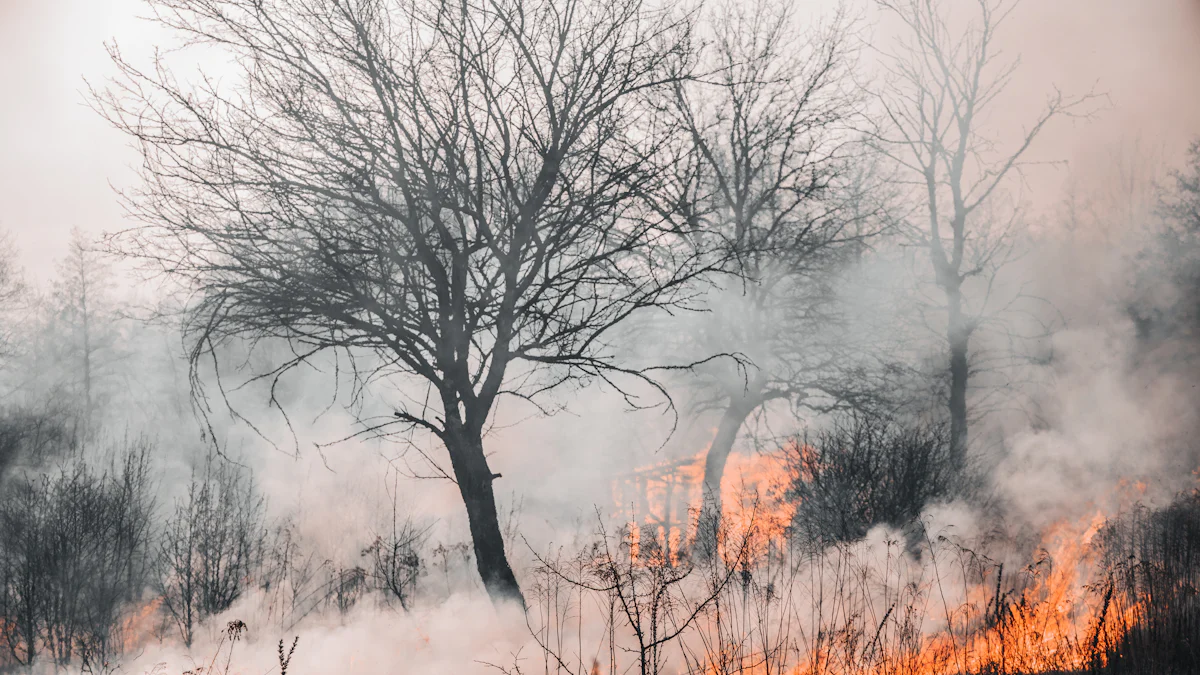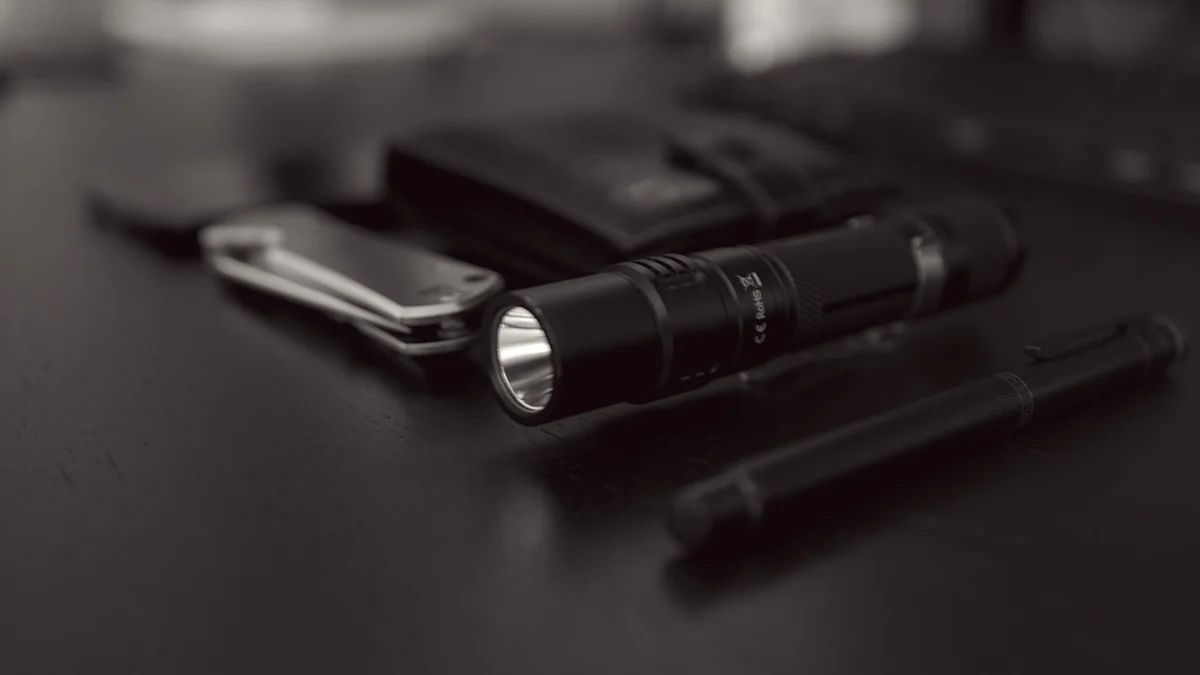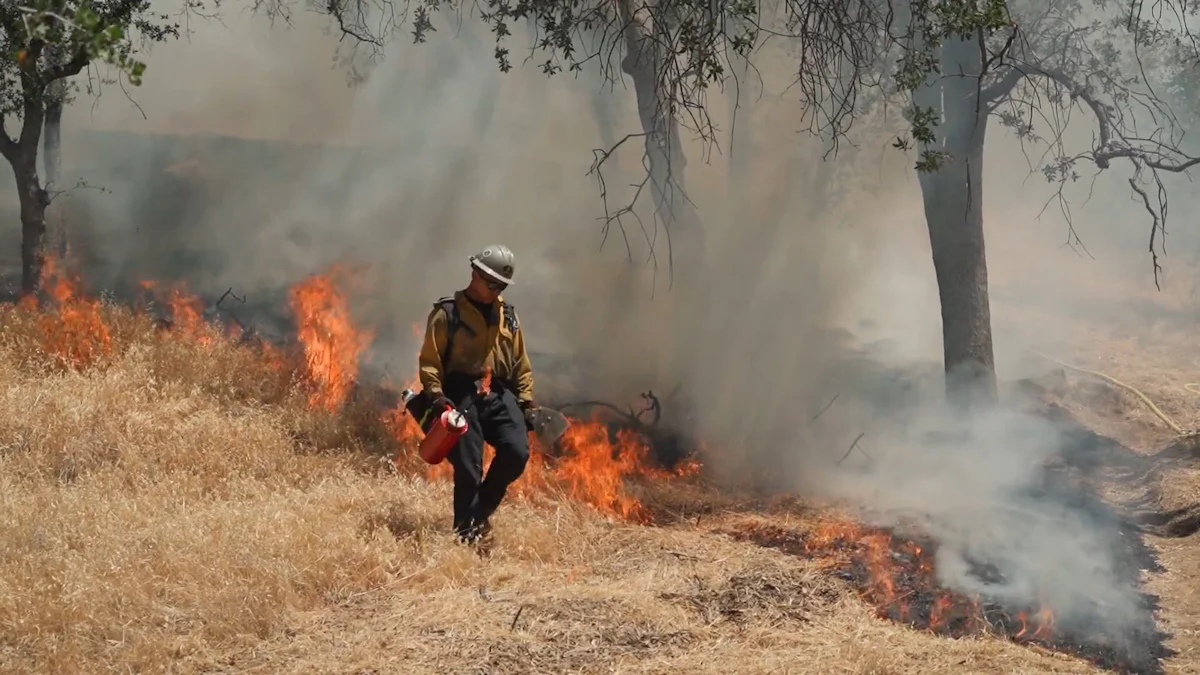How Flashlights Can Help You Stay Safe During Wildfires and Evacuations

When wildfires strike, every second counts. You need tools that can help you stay safe and act quickly. Flashlights are one of the most essential items for wildfire safety. They cut through smoke, light up dark paths, and make it easier to find your way during an evacuation. A reliable flashlight isn’t just a convenience—it’s a critical part of your wildfire preparedness. Whether you’re signaling for help or navigating through debris, this small tool can offer big protection. Make sure it’s a priority in your emergency kit.
Key Takeaways
Flashlights help you see better in smoke and darkness. They let you avoid dangers and move safely during wildfires.
Use your flashlight to ask for help. Flash specific patterns, like SOS, to get rescuers' attention.
Pick a strong flashlight with long-lasting batteries and bright light. This makes sure it works well in emergencies.
Practice using your flashlight during drills. This builds confidence and helps everyone learn to use it in low light.
Keep extra batteries and another flashlight in your emergency kit. This prepares you for sudden power outages.
Why Flashlights Are Essential During Wildfires

Enhancing Visibility in Low-Light and Smoky Conditions
Wildfires often create thick smoke that blocks out natural light, making it hard to see even during the day. At night, the situation becomes even more dangerous. A flashlight can cut through the darkness and smoke, helping you stay aware of your surroundings. Whether you’re inside your home or outdoors, it ensures you can spot hazards like fallen branches, broken glass, or uneven terrain. This visibility is crucial for your safety, especially when you’re trying to evacuate quickly.
Navigating Safely Through Obstructions
Wildfires leave chaos in their wake. Roads may be blocked by debris, and familiar paths can become unrecognizable. A flashlight helps you navigate through these obstacles safely. Its beam can illuminate your path, making it easier to avoid tripping or injuring yourself. If you’re in a smoky area, aim the flashlight low to the ground where the air is clearer. This technique helps you see better and breathe easier. A headlamp can also be a great option, freeing up your hands to carry supplies or assist others during an evacuation.
Signaling for Help During Emergencies
If you’re trapped or need to attract attention, a flashlight becomes a powerful signaling tool. Rescue teams are trained to recognize specific light patterns. For example, you can flash three short bursts, three long bursts, and three short bursts to signal "SOS." This universal distress signal can be seen from a distance, even through smoke. Some flashlights and headlamps come with built-in strobe modes designed for emergencies. You can also use three short flashes followed by a pause to stand out from other lights in the area. These simple techniques can make all the difference when every second counts.
Providing Light During Power Outages
When wildfires hit, power outages often follow. You might lose electricity for hours or even days. Without light, simple tasks like finding supplies or moving around your home can become frustrating and dangerous. This is where a flashlight becomes your best friend.
A reliable flashlight gives you instant light when the power goes out. It helps you avoid tripping over furniture or stepping on sharp objects. If you need to check on family members or pets, a flashlight makes it easier to move safely through dark spaces. You can also use it to inspect your home for fire damage or locate important items like your emergency kit.
Rechargeable flashlights are especially useful during extended outages. Pair them with a portable power bank to keep them charged. Solar-powered or crank flashlights are also great options since they don’t rely on batteries. These tools ensure you always have light, even when traditional power sources fail.
If you’re evacuating during a wildfire, a flashlight can guide you through unfamiliar areas. It’s also helpful for signaling to others in your group or alerting rescue teams to your location. Keep one flashlight in your emergency kit and another in an easy-to-reach spot at home.
Tip: Store extra batteries or a backup flashlight in case your primary one runs out of power.
Don’t wait until the lights go out to realize how important this tool is. A flashlight can make all the difference when you’re facing the challenges of a wildfire.
Choosing the Right Flashlight for Wildfire Evacuations

When it comes to wildfire evacuation, having the right flashlight can make all the difference. Not all flashlights are created equal, so knowing what to look for ensures you’re prepared for any situation. Let’s break it down.
Key Features to Consider
Long Battery Life and Rechargeability
You don’t want your flashlight dying in the middle of an emergency. Look for one with a long runtime—ideally lasting several days. Rechargeable options are great, especially when paired with a solar charger or battery pack. This way, you’ll always have light, even if you’re off the grid.
High Brightness and Adjustable Beam Distance
Brightness matters when you’re navigating through smoke or darkness. Flashlights with high lumens provide powerful illumination, while adjustable beams let you focus on specific areas or widen the light to see more of your surroundings. Both features are essential for safety during a wildfire evacuation.
Durability and Water Resistance
Wildfires create tough conditions. Your flashlight should handle drops, heat, and even water. Look for models with shockproof and water-resistant designs. These features ensure your flashlight works when you need it most, even in unpredictable environments.
Types of Flashlights for Emergencies
Handheld Flashlights for Versatility
Handheld flashlights are classic for a reason. They’re easy to carry and often come with features like clips or colored lens filters. These extras make them versatile tools for any evacuation plan.
Headlamps for Hands-Free Use
When you need both hands free—whether to carry supplies or help others—a headlamp is your best bet. It keeps your path lit while letting you focus on other tasks. This is especially useful when following your escape plan in low-visibility conditions.
Solar-Powered and Crank Flashlights for Sustainability
If you’re worried about running out of batteries, solar-powered or crank flashlights are lifesavers. They don’t rely on traditional power sources, making them perfect for long evacuations or extended power outages.
Tips for Selecting Reliable Flashlight Brands
Not sure which brand to trust? Some of the most reliable options include Eveready, Nitecore, Olight, GearLight, Maglite, Streamlight, and Surefire. These brands are known for their durability, brightness, and long battery life. When choosing, prioritize models with high lumens, sturdy construction, and versatile features. A flashlight that checks all these boxes is worth the investment for your safety and preparation.
Pro Tip: Always keep flashlights with extra batteries in your emergency kit. This ensures you’re ready for any situation, whether it’s a wildfire evacuation or a power outage.
How to Use Flashlights Effectively to Stay Safe During Wildfires
Navigating Smoke-Filled Areas with Flashlights
When wildfires spread, smoke can make it hard to see and breathe. A flashlight becomes your best tool for navigating through these conditions. Aim the beam low to the ground, where the air is usually clearer. This technique helps you see obstacles like debris or uneven terrain while reducing the amount of smoke you inhale. If you’re evacuating at night, a headlamp can be especially useful. It keeps your hands free to carry supplies or assist others while lighting your path.
Keep your flashlight close and ready to use. If you’re indoors, use it to check for fire damage or locate exits. Outdoors, it can guide you through unfamiliar areas or help you follow an evacuation route. Always have a backup flashlight or extra batteries in case your primary one runs out of power.
Using Flashlights to Signal for Rescue
If you need to call for help during a wildfire evacuation, your flashlight can act as a lifesaver. Rescue teams are trained to recognize specific light signals. Flash three short bursts, three long bursts, and three short bursts to send an SOS signal. This universal distress call works well at night and can cut through smoke.
Another effective method is flashing three short bursts followed by a pause. This rhythmic pattern helps your signal stand out from other lights in the area. Some flashlights come with built-in strobe modes designed for emergencies. Use these features to increase your chances of being spotted by rescue teams.
Conserving Battery Life During Extended Emergencies
In a wildfire emergency, you never know how long you’ll need your flashlight. Conserve its battery life by using it only when necessary. Switch to a lower brightness setting if your flashlight has one. Avoid leaving it on continuously—turn it off when you don’t need it.
Rechargeable flashlights are a great option for extended emergencies. Pair them with a portable power bank or solar charger to keep them running. If you’re using a flashlight with replaceable batteries, store extras in your emergency kit. This ensures you’ll have light when you need it most.
Tip: Test your flashlight regularly to make sure it’s working properly. Replace old batteries before they run out to avoid surprises during an evacuation order.
By using your flashlight wisely, you can stay safe, conserve resources, and navigate the challenges of a wildfire evacuation with confidence.
Coordinating with Others Using Flashlight Signals
When wildfires create chaos, staying connected with others becomes critical. Flashlight signals are a simple yet effective way to communicate, especially when noise, distance, or smoke makes verbal communication difficult. Knowing how to use these signals can help you coordinate with family, neighbors, or rescue teams during an evacuation.
Start by agreeing on basic signals with your group. For example:
One flash could mean "Stop."
Two flashes might signal "Come here."
Three flashes could indicate "Emergency."
Keep the signals simple and consistent so everyone understands them. Practice these signals ahead of time to avoid confusion during an actual emergency.
If you’re in a group, use your flashlight to guide others. Sweep the beam across the ground to highlight obstacles or safe paths. This is especially helpful in low-visibility conditions. If you’re separated, flash your light in short bursts to help others locate you. A headlamp works well for this since it keeps your hands free for other tasks.
For larger groups or rescue teams, pre-arranged patterns like flashing three times in quick succession can signal your location. Avoid shining the light directly into someone’s eyes. Instead, aim it at the ground or nearby objects to maintain visibility without blinding others.
Tip: Use a flashlight with a strobe mode for emergencies. The pulsing light grabs attention and can be seen from far away, even through smoke.
Flashlight signals are a lifeline when communication is tough. By using them effectively, you can stay connected and ensure everyone’s safety during a wildfire evacuation.
Additional Safety Tips to Stay Safe During Wildfires
Complementary Tools to Pair with Flashlights
Emergency Whistles and Signal Mirrors
Flashlights are powerful, but pairing them with other tools can boost your safety during a wildfire. Emergency whistles are small but mighty. Their sharp sound can cut through the chaos, helping rescuers locate you even if you’re surrounded by smoke or debris. Keep one in your emergency kit for quick access.
Signal mirrors are another great addition. On sunny days, they can reflect sunlight to create a bright flash visible from miles away. At night, you can use your flashlight or headlamp to mimic this effect. Flash three short bursts followed by a pause to send a clear distress signal. This combination of light and sound ensures you have multiple ways to call for help when you need it most.
Portable Power Banks for Recharging Flashlights
A flashlight is only as good as its power source. That’s why a portable power bank is a must-have. These handy devices let you recharge your flashlight during extended emergencies or evacuations. Choose a power bank with enough capacity to charge multiple devices, including your phone. Solar-powered options are especially useful if you’re away from traditional power sources. With this backup, you’ll always have light when you need it.
Building a Comprehensive Emergency Kit
To stay safe during wildfires, you need more than just a flashlight. A well-stocked emergency kit is essential. Start with basics like non-perishable food, water, and first aid supplies. Add medications, important documents, and a multi-tool. Don’t forget items like a dust mask, local maps, and a manual can opener.
Here’s a quick checklist to help you prepare an emergency kit:
Flashlight
Whistle
Dust mask
Local maps
Manual can opener
Battery-powered or hand-cranked radio
First aid kit
Supplies for your pet
Wrench or pliers
Books or games for kids
Store your kit in an easy-to-carry bag so you can grab it quickly during an evacuation. Regularly check and update it to ensure everything is in working order.
Practicing Evacuation Drills with Flashlights
Preparation is key to staying safe. Practicing evacuation drills with your flashlight can make a big difference. Start by creating a clear plan for your family. Identify escape routes, designate a meeting point, and assign roles. Then, practice the plan using your flashlight to simulate low-visibility conditions.
During the drill, test your flashlight’s brightness and battery life. Practice signaling for help and navigating obstacles. If you have kids, turn it into a game to keep them engaged. These drills help everyone feel more confident and prepared when it’s time to evacuate.
Tip: Practice your evacuation plan at least twice a year. This ensures everyone knows what to do and where to go during a wildfire.
By pairing your flashlight with complementary tools, building a solid emergency kit, and practicing evacuation drills, you’ll be better prepared to face wildfires and stay safe.
Flashlights are more than just tools—they’re lifesavers when you need to stay safe during wildfires. They provide light when power is out, help you navigate dark or unfamiliar areas, and let you signal for help in emergencies. Choosing the right flashlight and knowing how to use it effectively can make a huge difference in your safety.
Make flashlights a priority in your emergency plan. Keep one in your kit, test it regularly, and practice using it during drills. Being prepared ensures you and your loved ones can stay safe no matter what challenges come your way.
FAQ
What type of flashlight is best for wildfire emergencies?
Choose a durable flashlight with long battery life, high brightness, and water resistance. Rechargeable models or solar-powered options work great for extended use. A headlamp is also handy for hands-free tasks.
How many flashlights should I keep in my emergency kit?
Keep at least two flashlights—one primary and one backup. Add extra batteries or a solar-powered flashlight for extended emergencies. This ensures you’re prepared if one fails.
Can I use my phone’s flashlight during a wildfire?
Your phone’s flashlight works in a pinch, but it drains the battery quickly. Save your phone for communication. A dedicated flashlight is more reliable and lasts longer in emergencies.
How do I maintain my flashlight for emergencies?
Test your flashlight monthly. Replace old batteries and check for damage. Store it in a dry, accessible spot. Rechargeable flashlights should be fully charged and ready to go.
Are crank flashlights worth it?
Yes! Crank flashlights don’t rely on batteries, making them perfect for long emergencies. A few minutes of cranking provides light, so you’ll never run out of power when you need it most.
See Also
Why Rechargeable Flashlights Are Crucial for Community Safety
Hunting Flashlights: Must-Have Gear for Outdoor Lovers
A Homeowner's Guide to Selecting the Ideal Emergency Flashlight
SF1 Camping Flashlight: Brighten Up Your Outdoor Experiences
Camping Essentials: Comparing Lanterns and Flashlights for Illumination
